
The Shiva Panchakshara Stotram is a revered devotional hymn dedicated to Lord Shiva, emphasizing the Panchakshara Mantra, “Om Nama Shivaya.” Its significance lies in its transformative power;
1.1 What is Shiva Panchakshara Stotram?
The Shiva Panchakshara Stotram is a sacred hymn in Hindu devotion, composed by Adi Shankaracharya, consisting of five verses that glorify Lord Shiva. It revolves around the Panchakshara Mantra, “Om Nama Shivaya,” which is considered the essence of Shiva worship. This stotram is a powerful tool for spiritual growth, emphasizing the dissolution of sins and the attainment of liberation. Its simplicity and profundity make it accessible to all devotees, fostering a deep connection with the divine. The stotram is widely recited in temples and homes, and its Telugu PDF version is popular among devotees for easy access and daily recitation.
1.2 Significance of the Stotram in Hindu Devotion
The Shiva Panchakshara Stotram holds immense significance in Hindu devotion as a powerful hymn that embodies the essence of Shiva worship. It is believed to purify the mind, bestow spiritual enlightenment, and grant liberation from worldly bondage. The stotram’s recitation is considered a direct means to connect with Lord Shiva, fostering devotion and inner peace. Its simplicity and profound meaning make it a cornerstone of daily worship for many devotees. The availability of the Telugu PDF version has further enhanced its accessibility, allowing devotees to recite it effortlessly and experience its divine grace in their spiritual journey.
1.3 Overview of the Panchakshara Mantra
The Panchakshara Mantra, “Om Nama Shivaya,” is a five-syllable mantra central to the Shiva Panchakshara Stotram. It is revered as a potent tool for spiritual growth, embodying the essence of Shiva worship; Each syllable—Om, Na, Ma, Shi, Va, Ya—holds profound significance, symbolizing the unity of the individual soul with the supreme consciousness. This mantra is believed to purify the mind, ward off negativity, and bestow divine grace. Its simplicity makes it accessible to all devotees, while its depth resonates deeply in Hindu spirituality. Recitation of this mantra is considered a direct path to connecting with Lord Shiva, fostering inner peace and liberation.
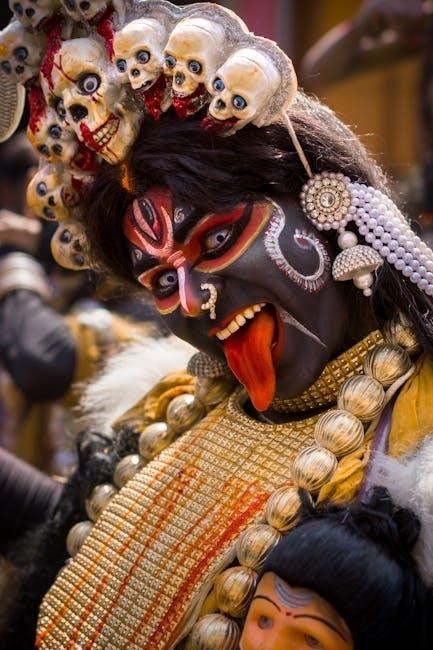
Origins and Historical Background
The Shiva Panchakshara Stotram is an ancient hymn rooted in Hindu scriptures, composed by Adi Shankaracharya. It is believed to have originated from Shiva’s teachings to Parvati.
2.1 Composition and Authorship
The Shiva Panchakshara Stotram is attributed to the revered sage Adi Shankaracharya, a prominent figure in Hindu spirituality. While its exact composition date remains unclear, it is believed to have been written during the 8th century CE. The stotram is composed in Sanskrit, with translations available in various languages, including Telugu. Its authorship is often linked to Shankaracharya’s efforts to simplify and popularize devotion to Lord Shiva. The Telugu PDF version of the stotram is widely accessible, offering devotees a convenient way to recite and understand its profound verses. This version retains the original spiritual essence and lyrical beauty.
2.2 Historical Significance in Hindu Scriptures
The Shiva Panchakshara Stotram holds a revered place in Hindu scriptures, tracing its roots to ancient Vedic traditions. It is often cited in texts like the Vedas and Upanishads, emphasizing the potency of the Panchakshara Mantra. This stotram is considered a concise yet powerful expression of devotion to Lord Shiva, reflecting the essence of His cosmic significance. Its historical prominence is evident in its inclusion in various ritualistic practices and its mention in revered works by spiritual leaders. The stotram’s enduring relevance highlights its deep integration into Hindu spiritual culture, making it a timeless hymn for seekers of divine connection. Its influence endures across generations.
2;3 Role of Adi Shankaracharya in Popularizing the Stotram
Adi Shankaracharya played a pivotal role in popularizing the Shiva Panchakshara Stotram by integrating it into Hindu philosophical and devotional practices. He emphasized the stotram’s spiritual potency and its alignment with non-dualistic Vedanta. Shankaracharya often recited and taught the Panchakshara Mantra, “Om Nama Shivaya,” to his disciples, highlighting its simplicity and profound essence. His endorsement elevated the stotram’s status, making it a cornerstone of Shiva worship. Through his writings and teachings, Shankaracharya ensured the stotram’s widespread dissemination, embedding it deeply into Hindu tradition and ensuring its relevance for centuries. His influence remains a cornerstone of its enduring popularity and spiritual significance.
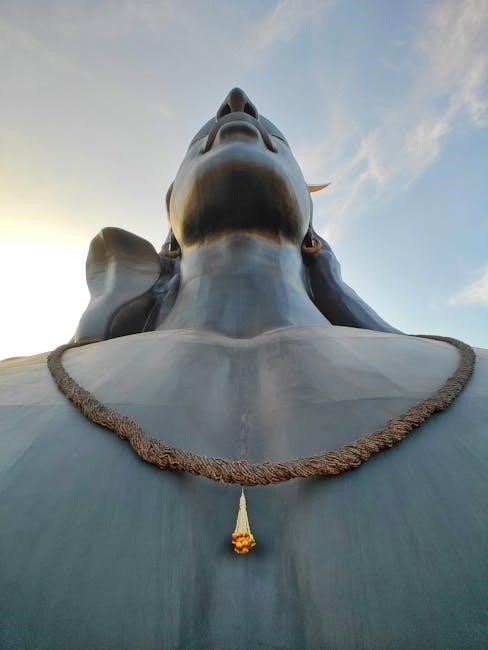
Structure and Content of the Stotram
The Shiva Panchakshara Stotram consists of sacred verses glorifying Lord Shiva, with the Panchakshara Mantra, “Om Nama Shivaya,” at its core, embodying devotion and spiritual essence.
3.1 Number of Verses and Their Meaning
The Shiva Panchakshara Stotram consists of 28 verses, each imbued with profound spiritual significance. These verses glorify Lord Shiva, extolling his divine attributes and cosmic manifestations. Each stanza is crafted to evoke devotion, with meanings that range from praising Shiva’s omnipresence to seeking liberation through his grace. The stotram also emphasizes the Panchakshara Mantra, “Om Nama Shivaya,” reinforcing its central role in worship. The verses are structured to guide devotees toward spiritual enlightenment, offering both philosophical insights and emotional solace. Their rhythmic and poetic composition makes them accessible for recitation, ensuring a deep connection with the divine essence of Shiva.
3.2 The Panchakshara Mantra: “Om Nama Shivaya”
The Panchakshara Mantra, “Om Nama Shivaya,” is the cornerstone of the Shiva Panchakshara Stotram. Comprising five syllables, it embodies the essence of Lord Shiva, symbolizing his divine presence and cosmic energy. This mantra is revered as a powerful tool for spiritual growth, offering devotees a pathway to liberation. Each syllable—Om, Na, Ma, Shi, Va, Ya—carries profound significance, representing the union of the individual self with the universal consciousness. Chanting this mantra is believed to purify the soul, bestow divine grace, and foster a deep connection with Shiva. Its recitation is a cornerstone of Shiva worship, fostering devotion and inner peace.
3.3 Language and Literary Style
The Shiva Panchakshara Stotram is composed in Sanskrit, reflecting the rich literary traditions of ancient Hindu scriptures. Its Telugu version maintains the original spiritual essence, with a poetic style that blends devotion and philosophical depth. The stotram’s language is simple yet profound, making it accessible to all devotees. It employs rhyme, rhythm, and repetition, enhancing its chanting appeal. The literary style emphasizes emotional connection, using vivid imagery and metaphors to glorify Lord Shiva. The Telugu adaptation preserves the stotram’s spiritual significance while catering to regional devotees, ensuring its timeless relevance and universal appeal. Its structure and metre are designed for melodious recitation.
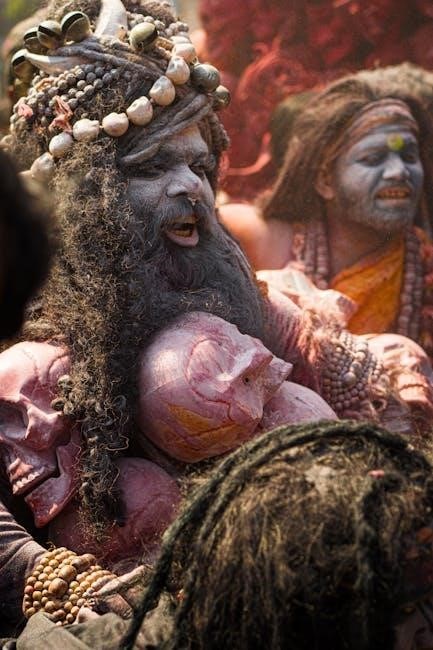
Benefits of Reciting Shiva Panchakshara Stotram
Reciting the stotram brings spiritual growth, inner peace, and devotion. It enhances meditation, emotional well-being, and offers protection. Devotees believe it grants blessings, prosperity, and liberation from sins.
4.1 Spiritual Benefits and Inner Peace
Reciting the Shiva Panchakshara Stotram brings profound spiritual benefits, fostering inner peace and calmness. The mantra “Om Nama Shivaya” is believed to purify the soul, offering liberation from worldly bondage. Devotees experience a deep connection with Lord Shiva, leading to emotional balance and mental clarity. Regular recitation helps in meditation, quieting the mind and fostering self-realization. Many have shared transformative experiences, stating that the stotram has brought them closer to divine consciousness, reducing stress and anxiety. Its rhythmic chant creates a meditative atmosphere, helping seekers attain spiritual harmony and inner tranquility, making it a powerful tool for spiritual growth and enlightenment.
4.2 Emotional and Mental Well-being
The Shiva Panchakshara Stotram is a powerful tool for enhancing emotional and mental well-being. Its recitation is known to alleviate stress, anxiety, and emotional turmoil. By chanting the Panchakshara Mantra, “Om Nama Shivaya,” devotees experience a calming effect on the mind. This ancient hymn is believed to harmonize the emotions, fostering resilience against life’s challenges. Many practitioners report feeling mentally light and emotionally balanced after reciting it regularly. The stotram’s soothing vibrations help in managing negative emotions, promoting a state of inner stability. It serves as a spiritual balm, healing emotional wounds and nurturing a peaceful, composed mindset, essential for overall well-being.
4.3 Material and Worldly Benefits
The Shiva Panchakshara Stotram is believed to bestow material and worldly benefits upon its devotees. Reciting the stotram is thought to attract prosperity, success, and good fortune. It is said to enhance career growth, improve financial stability, and foster harmonious relationships. Many believers report experiencing positive changes in their lives, such as overcoming obstacles and achieving their goals. The stotram is also considered a shield against negative energies, protecting the reciter from adversity. By invoking Lord Shiva’s blessings, devotees seek to manifest abundance and happiness in their lives. Its recitation is often recommended during auspicious occasions to amplify its beneficial effects.
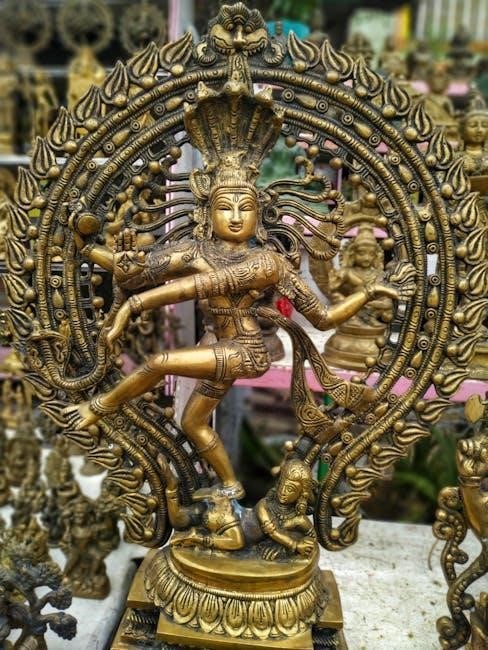
How to Recite the Stotram Properly
To recite the Shiva Panchakshara Stotram properly, one should maintain purity of mind and body. It is ideal to recite it in the early morning or evening.
5.1 Best Time for Recitation
The ideal time for reciting the Shiva Panchakshara Stotram is during the early morning hours, known as Brahma Muhurta, or in the evening after sunset. These periods are considered sacred and conducive for spiritual practices. Devotees often recite it during festivals like Maha Shivaratri for heightened spiritual benefits. Consistent daily recitation is encouraged, especially after bathing and performing basic rituals, to maintain a strong connection with Lord Shiva. The mantra’s potency is believed to amplify during these times, fostering inner peace and spiritual growth. Regular recitation at these hours is said to bring balance and harmony to one’s life.
5.2 Ideal Place and Environment
For the recitation of Shiva Panchakshara Stotram, it is essential to choose a clean, calm, and sacred environment. Ideally, one should recite it in a temple, home altar, or a serene outdoor setting like a riverbank. The space should be free from distractions, fostering a deep connection with Lord Shiva. Facing East or North is considered auspicious. Lighting a lamp or incense can enhance the spiritual ambiance. Many devotees prefer to recite the stotram in front of a Shiva Lingam or an image of Lord Shiva, as it amplifies the divine energy. A peaceful and reverent atmosphere is key to experiencing the mantra’s full potential.
5.3 Rituals and Preparations
To recite the Shiva Panchakshara Stotram effectively, certain rituals and preparations are recommended. Devotees should begin by purifying themselves with a bath and wearing clean clothes. Offering flowers, fruits, and water to Lord Shiva is a common practice. Lighting a lamp or burning incense creates a sacred atmosphere. Many devotees perform a brief puja before starting the recitation. Chanting the mantra 108 times, especially during auspicious times like Maha Shivaratri, is believed to enhance its benefits. Maintaining a focused and pure heart ensures the recitation’s effectiveness. These rituals and preparations help in invoking Lord Shiva’s blessings and grace.
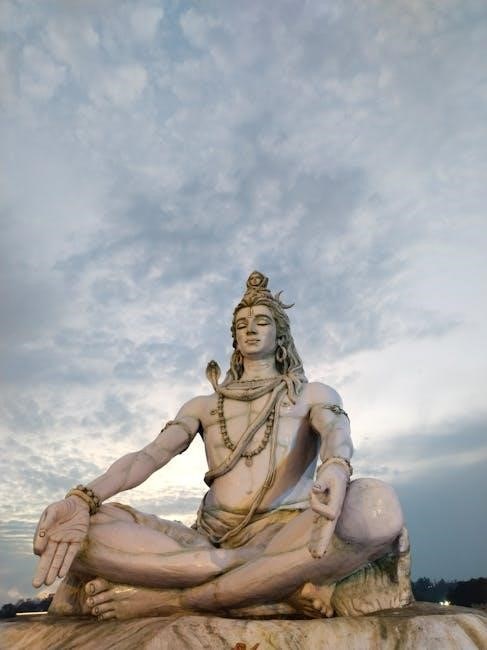
Shiva Panchakshara Stotram in Telugu
The Shiva Panchakshara Stotram is widely available in Telugu, offering devotees a meaningful way to connect with Lord Shiva through its transliterated verses and spiritual essence.
6.1 Availability of Telugu PDF Version
The Telugu PDF version of the Shiva Panchakshara Stotram is widely available for download on various spiritual and religious websites.
It can also be found on platforms like Google Drive, e-bookstores, and temple websites, making it easily accessible to devotees worldwide.
The PDF typically includes the stotram’s lyrics in Telugu, along with their meanings and significance, catering to both devotees and learners.
Additionally, it is often accompanied by guides on pronunciation and recitation, enhancing the spiritual experience for those who recite it.
Devotees can download and store it on their devices for daily recitation, ensuring its convenience and portability.
6.2 Features of the Telugu PDF
The Telugu PDF of Shiva Panchakshara Stotram is designed with clear formatting, making it easy to read and recite.
It typically includes the stotram’s lyrics in Telugu script, along with their English translations for better understanding.
The PDF often features detailed explanations of the Panchakshara Mantra, highlighting its spiritual significance and benefits.
Some versions include audio links or pronunciation guides to help devotees recite the stotram accurately.
Additionally, the PDF may incorporate images of Lord Shiva or sacred symbols, enhancing its devotional appeal.
Overall, the Telugu PDF is a comprehensive resource for both spiritual seekers and regular devotees.
6.3 Where to Download the Telugu PDF
The Shiva Panchakshara Stotram in Telugu PDF is readily available on various spiritual and religious websites.
Popular platforms like Scribd, Google Drive, and temple websites often host this PDF for free download.
Additionally, official websites of Hindu temples and cultural organizations provide downloadable links for devotees.
Some PDF versions include audio links or images, enhancing the devotional experience for users.
Simply searching with keywords like “Shiva Panchakshara Stotram Telugu PDF” yields multiple reliable sources.
Ensure to download from trusted sites to maintain authenticity and safety.
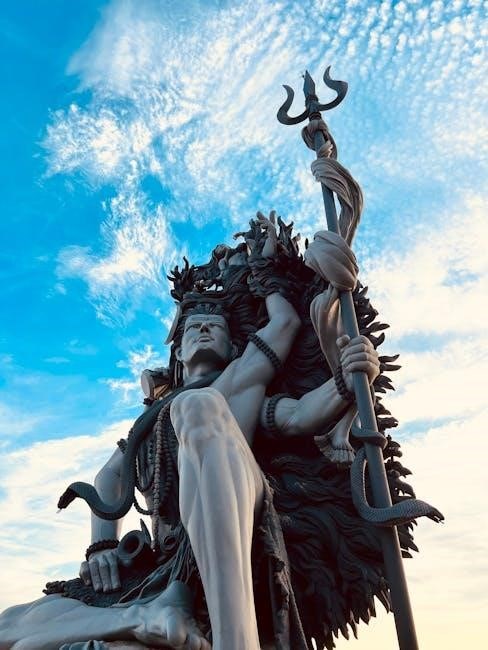
Cultural and Religious Significance
The Shiva Panchakshara Stotram holds profound cultural and religious significance, being a central part of Shiva worship in temples and homes during festivals and rituals.
7.1 Role in Hindu Festivals and Rituals
The Shiva Panchakshara Stotram holds a prominent place in Hindu festivals and rituals, particularly during Maha Shivaratri and other Shiva-centric celebrations. Devotees recite the stotram to invoke Lord Shiva’s blessings, seeking spiritual enlightenment and forgiveness. It is often chanted in temples and homes, accompanied by offerings like water, flowers, and bilva leaves. The stotram’s recitation is believed to purify the environment and the soul, fostering a deeper connection with the divine. During rituals, its chanting is considered a powerful way to honor Shiva and seek his grace, making it an integral part of Hindu religious practices and cultural traditions.
7.2 Influence on Devotional Music and Art
The Shiva Panchakshara Stotram has profoundly influenced devotional music and art, inspiring numerous compositions and performances. Renowned artists and musicians have rendered the stotram in melodious tunes, blending traditional ragas with heartfelt devotion. In Telugu, the stotram’s verses are often set to soul-stirring music, creating a spiritual ambiance that resonates deeply with listeners. Devotional albums and live performances frequently feature this stotram, showcasing its timeless appeal. Additionally, its verses have motivated visual artists to create paintings and sculptures depicting Lord Shiva, further enriching Hindu cultural heritage. This integration of the stotram into music and art underscores its enduring impact on spiritual expression.
7.3 Role in Shiva Temples and Worship
The Shiva Panchakshara Stotram holds a central place in Shiva temples, where it is regularly recited during pujas and rituals. Devotees often chant this stotram to invoke Lord Shiva’s blessings, seeking spiritual purification and divine grace. In many temples, the stotram is sung collectively, creating a unified and sacred atmosphere. The Telugu PDF version of the stotram is widely used in temple ceremonies, making it accessible for devotees to follow and participate. This practice strengthens the bond between worshippers and the deity, fostering a deeper connection to Shiva’s divine essence. Its inclusion in temple rituals underscores its significance in Hindu worship traditions.
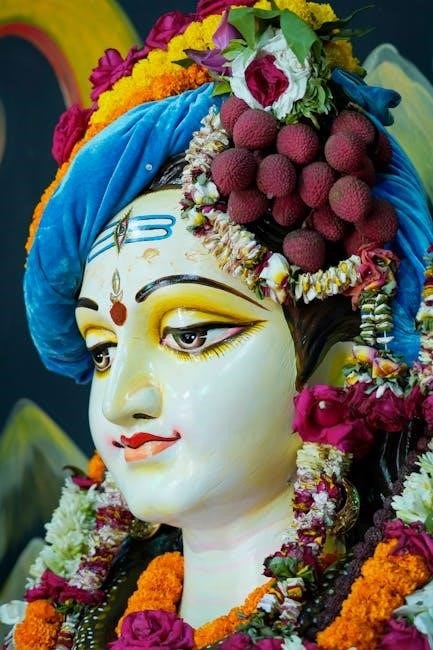
Modern Relevance and Popularity
The Shiva Panchakshara Stotram remains highly relevant today, with its Telugu PDF version widely accessed for digital recitation. Its soothing chants and profound meaning resonate deeply in modern spirituality.
8.1 Digital Availability and Accessibility
The Shiva Panchakshara Stotram in Telugu is widely available in digital formats, making it easily accessible to devotees worldwide. Numerous websites offer free PDF downloads of the stotram, allowing users to access it anytime. Popular platforms like Isha Foundation and other spiritual portals provide high-quality versions with clear lyrics and meanings. Additionally, mobile apps dedicated to Hindu scriptures and devotional content feature the stotram, enabling devotees to recite it on-the-go. Its digital presence ensures that the stotram remains relevant and reachable in the modern era, catering to both tech-savvy youth and traditional practitioners. This accessibility has significantly contributed to its enduring popularity.
8.2 Use in Meditation and Yoga Practices
The Shiva Panchakshara Stotram has become an integral part of meditation and yoga practices, offering a spiritual anchor for practitioners. Its calming rhythm and profound mantra, “Om Nama Shivaya,” help seekers attain inner peace and focus. Many yoga instructors incorporate the stotram into their sessions, using its lyrical flow to synchronize breath and movement. During meditation, reciting the stotram is believed to purify the mind and connect the practitioner with divine energy. The Telugu version, accessible through PDFs and digital platforms, is often used in guided meditation sessions, enhancing its universal appeal and spiritual impact, making it a favorite among modern yogis.
8;3 Impact on Contemporary Spirituality
The Shiva Panchakshara Stotram has profoundly influenced contemporary spirituality by bridging ancient traditions with modern practices. Its timeless message of devotion and self-realization resonates deeply, offering solace in today’s fast-paced world. The stotram’s digital availability, especially in Telugu PDF formats, has made it accessible to a global audience, inspiring a new generation of spiritual seekers. Its recitation is increasingly incorporated into modern meditation and mindfulness practices, fostering inner peace and emotional balance. The stotram’s universal appeal lies in its simplicity and depth, making it a cornerstone of contemporary spirituality for those seeking harmony and connection to the divine.

Famous Renditions and Recitations
The Shiva Panchakshara Stotram has been beautifully rendered by renowned artists, enhancing its reach and spiritual impact. Popular audio versions in Telugu PDF formats have gained widespread acclaim.
9.1 Notable Artists and Their Performances
The Shiva Panchakshara Stotram has been beautifully rendered by several renowned artists, whose soulful performances have captivated devotees worldwide. Anup Jalota, a prominent devotional singer, is celebrated for his heartfelt rendition, blending classical and contemporary styles. Similarly, Hariharan’s mesmerizing voice brings depth to the stotram, resonating with spiritual seekers. S.P. Balasubrahmanyam, a legendary artist, has also contributed a memorable version, infusing it with emotional essence. These performances not only enhance the stotram’s accessibility but also ensure its timeless appeal, making it a cherished part of devotional music. Their contributions have played a significant role in popularizing the stotram across generations.
9.2 Popular Audio Versions and Tracks
The Shiva Panchakshara Stotram is widely available in various audio formats, catering to diverse devotional preferences. Popular platforms like Spotify, YouTube, and Gaana host numerous renditions, featuring artists such as Anup Jalota, Hariharan, and S.P. Balasubrahmanyam. These tracks are often accompanied by soothing instrumental arrangements, enhancing the spiritual ambiance. Some versions include chanting with transliterations, aiding language barriers. Additionally, many recordings offer guided meditations or serene background scores, making them ideal for both personal worship and group recitations. The digital accessibility ensures that devotees worldwide can immerse themselves in the stotram’s divine vibrations, fostering a deeper connection with Lord Shiva.
9.3 Use in Films, TV Shows, and Media
The Shiva Panchakshara Stotram has been featured in various films, TV shows, and media, enhancing its cultural impact. For instance, the stotram’s rendition by renowned artists is often played during pivotal scenes in devotionally themed movies and serials. In the popular TV series “Devon ke Dev Mahadev,” the Panchakshara Mantra was prominently used, captivating audiences and deepening its spiritual resonance. Additionally, the stotram’s inclusion in documentaries and cultural programs has further amplified its reach. This integration into modern media has not only preserved its traditional significance but also introduced it to younger generations, ensuring its enduring relevance in contemporary spirituality and entertainment.
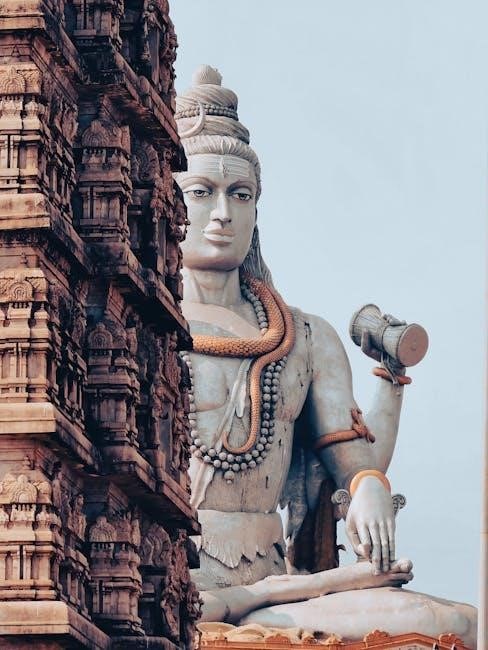
Personal Experiences and Devotee Stories
Many devotees share transformative experiences with the Shiva Panchakshara Stotram, recounting feelings of profound peace and divine blessings. Stories highlight its life-changing impact, as shared in the Telugu PDF.
10.1 Transformative Experiences of Devotees
Devotees worldwide share profound stories of transformation after reciting the Shiva Panchakshara Stotram. Many report experiencing deep inner peace, emotional stability, and spiritual awakening. One devotee mentioned that reciting the stotram during challenging times brought clarity and strength. Another shared how the mantra “Om Nama Shivaya” became a daily practice, fostering a sense of connection to Lord Shiva and improving their mental well-being. These testimonials highlight the stotram’s power to inspire positive change and provide solace in personal journeys. Such experiences underscore its enduring relevance and spiritual impact.
10.2 Stories of Faith and Miracles
Numerous devotees have shared miraculous experiences after reciting the Shiva Panchakshara Stotram. One devotee recounted how chanting the stotram during a critical health crisis led to a speedy recovery. Another shared how reciting “Om Nama Shivaya” brought prosperity and resolved long-standing financial struggles. A devotee mentioned that after reciting the stotram, they found their dream job unexpectedly. Such stories highlight the stotram’s divine power and its ability to manifest miracles in believers’ lives. These accounts of faith and divine intervention inspire many to embrace the stotram as a means to connect with Lord Shiva and seek His blessings.
10.3 How the Stotram Changed Lives
The Shiva Panchakshara Stotram has profoundly transformed lives, offering spiritual growth and emotional solace. Many devotees report finding inner peace and clarity after regular recitation. One individual shared how chanting “Om Nama Shivaya” helped overcome addiction, while another found strength to cope with grief. The stotram’s divine energy is said to bring balance and harmony, fostering resilience in adversity. For some, it deepened their connection to Lord Shiva, inspiring a life of devotion and purpose. These testimonials illustrate the stotram’s power to elevate consciousness and guide individuals toward a path of self-realization and fulfillment. Its impact transcends the material, touching the soul deeply.
The Shiva Panchakshara Stotram is a powerful hymn that embodies divine grace and transformation. Its recitation brings spiritual awakening, peace, and profound life changes, inspiring devotees globally.
11.1 Summary of Key Points
The Shiva Panchakshara Stotram is a powerful devotional hymn dedicated to Lord Shiva, centered around the Panchakshara Mantra, “Om Nama Shivaya.” It holds profound spiritual significance, offering inner peace, emotional balance, and worldly benefits. Available in Telugu PDF, it is easily accessible for devotees, facilitating daily recitation. Its structure includes verses that glorify Shiva, emphasizing devotion and liberation. Reciting it with dedication brings transformative experiences, as shared by many devotees. This stotram remains a cornerstone of Hindu devotion, blending tradition with modern accessibility, ensuring its relevance in contemporary spirituality. Its impact on personal and spiritual growth is unparalleled.
11.2 Final Thoughts on the Stotram’s Importance
The Shiva Panchakshara Stotram holds immense spiritual and cultural significance, serving as a bridge to connect devotees with the divine essence of Lord Shiva. Its simplicity and profound meaning make it accessible to all, fostering devotion and inner peace. The stotram’s enduring popularity underscores its universal appeal, transcending time and language barriers. As a tool for spiritual growth, it guides seekers toward self-realization and liberation. Its availability in Telugu PDF further enhances its reach, ensuring that its timeless wisdom continues to inspire generations. This stotram remains a cherished treasure in Hindu spirituality, embodying the essence of devotion and divine connection.
11.3 Encouragement to Explore and Recite
Embracing the Shiva Panchakshara Stotram can be a life-transforming experience, offering spiritual growth and emotional balance. Its simplicity and profound meaning make it accessible to everyone, regardless of their familiarity with Hindu scriptures. Reciting this stotram fosters a deep connection with Lord Shiva, bringing peace and clarity to one’s life. With its availability in Telugu PDF, devotees can easily access and recite it, making it a convenient yet powerful tool for daily worship. By integrating this stotram into your spiritual practice, you invite divine grace and harmony into your life, paving the way for a fulfilling spiritual journey.